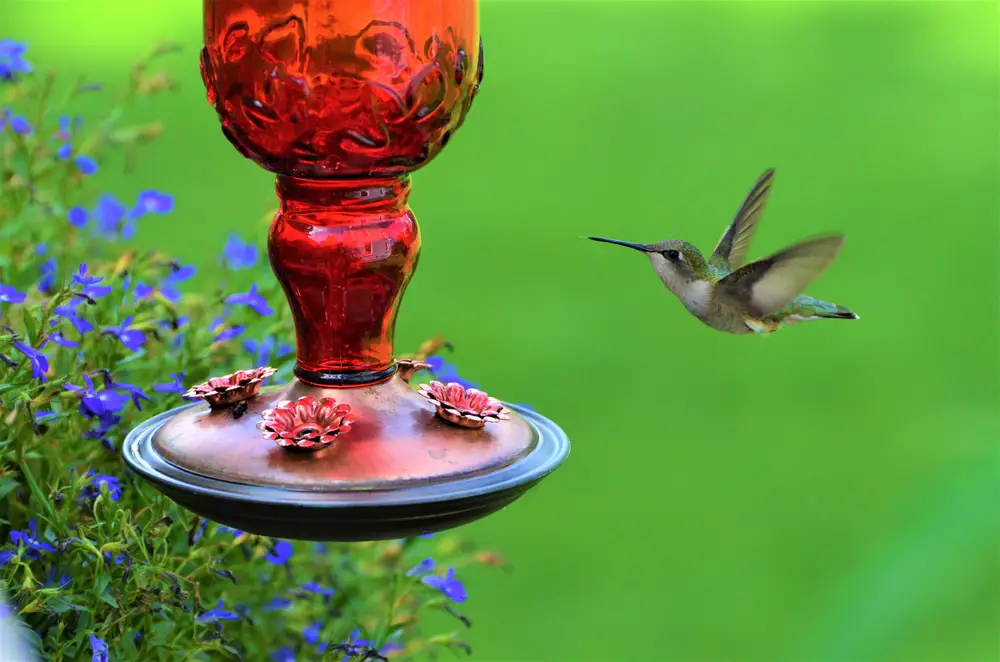You can cool hummingbird nectar by placing your feeders in the shade, using glass feeders, rotating your nectar reserves, placing ice cubes in the nectar, freezing your nectar into ice cubes, and applying water misters around feeders.
Ensuring that hummingbird nectar remains cool in the feeders during the summer can be rather challenging. This is because it degrades or starts to ferment at a faster rate when it is exposed to harsh, direct sunlight or ambient temperatures above 90 degrees Fahrenheit.
Table of Contents
Can hummingbird nectar get too hot?
Yes, hummingbird nectar can get too hot. Fortunately, there are several options to provide hummingbirds with safe, cool, and fresh nectar. They include the following:
Place Your Feeders in the Shade
Place your feeders in the shade, whether from a tree in a natural canopy or under an umbrella. Both these suggestions are essential but are only a part of the solution to keeping hummingbird nectar cool.
As a hummingbird enthusiast, practice good feeder placement during high temperatures in order to slow the nectar fermentation process. Good placement also means the hummingbirds will have a nice resting spot away from direct sunlight.
If sun exposure is unavoidable, you can place the
Purchase Glass Feeders
When it comes to hummingbird feeders and bird feeding, glass feeders are ideal. They’re especially useful for any local that experiences high ambient temperatures regularly—beyond 90 degrees or more. Glass feeders offer a thick barrier capable of withstanding outside atmospheric temperatures, and they also help to minimize fresh nectar from fermenting quickly in hot weather.
Another good thing about glass hummingbird feeders is that they are inert and do not react with chemicals. They are also easier to clean, are scratch resistant, and offer a hygienic environment. This minimizes the growth of fungus and bacteria, which could easily spread from one feeder to the next, causing distress for the hummingbirds.
Despite being more costly, a glass

Rotate Your Nectar Reserves
When dealing with high temperatures, rotating your homemade nectar will provide you with a constant supply of cool hydration for your hummingbird friends. Rotating your feeders also means preparing reserves of homemade nectar.
Use 1 cup of granulated white sugar, dissolved in a boil of about 4 cups of filtered or spring water. This ratio of sugar to water closely resembles the content of nectar naturally present in flowers.
Refrigerate Your Nectar
Frequently clean your hummingbird feeders and refill them with fresh nectar. If your refrigerator has enough space inside to accommodate your feeders, could keep some spare ones inside. You could then simply swap outside empty or hot feeders for fresh cool ones, repeatedly and as needed.
For serious hummingbird enthusiasts with many feeders, purchasing an affordable or used refrigerator is a great idea. Placing it in your garage may be an easier option for keeping your fresh nectar cool during hot weather.
Place some Frozen Ice Cubes in the Nectar
If rotating your nectar reserves becomes too time-consuming or you happen to be on a particular schedule, a quick and easy solution would be to add plain water ice cubes to your stock. If you decide to adopt this methodology, you should prepare concentrated fresh nectar using 1 cup of granulated sugar that is dissolved in 3 and ½ or 3 and ¾ cups of water. It has to be 3 parts water and 1 part sugar.
You can then add 1 cup of ice cubes to the feeder nectar and stir. This will bring the sugar concentrated levels back to the required 1:4 ratio, ensuring that it is not diluted and unstable for the hummingbirds. Its important to always check and test the temperature of any fresh nectar. Be certain it has cooled down enough before refilling and hanging hummingbird nectar.

Turn Your Nectar into Ice Cubes
Frozen sugar water tends to freeze at a lower temperature of about 27 degrees, which means that nectar ice cubes are more effective than regular ice cubes. You can make the best of the hot weather by filling ice cube trays with homemade hummingbird nectar and placing them in the freezer. You should also rotate the trays and repeat the process every now and then.
It is also important to remember that hummingbird nectar can sometimes be too cold for the birds, making them cold-stunned. As a result, make sure not to chill the nectar too much.
Apply Water Misters Around Feeder
A patio misting system can help to decrease the ambient temperatures around a
Hummingbirds also typically receive adequate hydration through the fresh nectar they consume. However, additional water sources are always welcome. Another good thing is that pre-assembled misters come with easy-to-use systems that take around 5 minutes to install.
Nonetheless, you should ensure your misting system has access to a water source close by, such as a water faucet or sprinkler. In case you have any concerns that the fine shower coming from the mister is a bit too strong or overwhelming for the hummingbirds, you could try placing them farther away from the feeder, which will help soften the spray.

